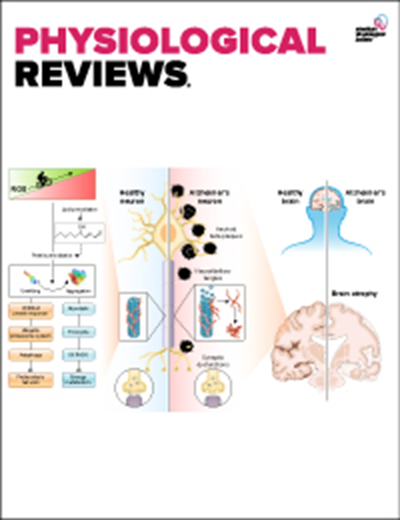Diaphragm Muscle: A Pump That Can Not Fail.
IF 28.7
1区 医学
Q1 PHYSIOLOGY
引用次数: 0
Abstract
In mammals, breathing requires an inspiratory pump to generate a negative intrathoracic pressure and thus pull air into the lungs for gas exchange. Exclusively in mammals, the diaphragm muscle (DIAm) is the major inspiratory pump, which separates the thoracic and abdominal cavities. With DIAm contraction a negative intrathoracic and positive abdominal pressure are generated (i.e., transdiaphragmatic pressure (Pdi). During breathing,the DIAm is very active, with a duty cycle (time active vs inactive) similar to that of the heart. Like the heart, this is a pump that cannot fail! Thus, in controlling breathing, the nervous system must activate DIAm to accomplish pump function while avoiding fatigue. The timing of DIAm activations must also be coordinated with activation of the upper airway muscles (the pipes) to avoid airway occlusion and aspiration, the intercostal and abdominal muscles to appropriately stiffen the body cavities. Similarly, neural control and coordination of the DIAm in non-ventilatory behaviors (airway protection, swallowing, vocalization and voiding) is equally complex, with coordinated activation of the DIAm and abdominal muscles. It is becoming increasingly clear that impaired non-ventilatory functions underlie the pathophysiology of a variety of medical conditions. In this review, we will delve into the detailed mechanistic underpinnings of the neural control of the DIAm and the symphonic coordination of its activation during breathing and other behaviors. We will attempt to move the field from considering the DIAm only as an inspiratory pump, emphasising neural control of airway, intercostal and abdominal muscles that must be coordinated with DIAm activation.横膈肌:一个不能失败的泵。
在哺乳动物中,呼吸需要一个吸气泵来产生负的胸内压,从而将空气吸入肺部进行气体交换。在哺乳动物中,隔膜肌(DIAm)是分隔胸腔和腹腔的主要吸气泵。DIAm收缩产生胸内负压和腹正压(即经膈压(Pdi))。在呼吸过程中,DIAm非常活跃,具有与心脏相似的占空比(活跃与不活跃的时间)。就像心脏一样,这是一个不能失败的泵!因此,在控制呼吸时,神经系统必须激活DIAm来完成泵功能,同时避免疲劳。DIAm的激活时间也必须与上气道肌肉(管道)的激活相协调,以避免气道闭塞和误吸,肋间肌和腹肌适当地硬化体腔。同样,在非通气行为(气道保护、吞咽、发声和排尿)中,DIAm的神经控制和协调也同样复杂,DIAm和腹部肌肉协同激活。越来越清楚的是,受损的非通气功能是各种医疗条件的病理生理学基础。在这篇综述中,我们将深入研究DIAm的神经控制及其在呼吸和其他行为中激活的交响协调的详细机制基础。我们将尝试改变将DIAm仅仅视为吸入泵的观点,强调气道、肋间肌和腹肌的神经控制必须与DIAm的激活相协调。
本文章由计算机程序翻译,如有差异,请以英文原文为准。
求助全文
约1分钟内获得全文
求助全文
来源期刊

Physiological reviews
医学-生理学
CiteScore
56.50
自引率
0.90%
发文量
53
期刊介绍:
Physiological Reviews is a highly regarded journal that covers timely issues in physiological and biomedical sciences. It is targeted towards physiologists, neuroscientists, cell biologists, biophysicists, and clinicians with a special interest in pathophysiology. The journal has an ISSN of 0031-9333 for print and 1522-1210 for online versions. It has a unique publishing frequency where articles are published individually, but regular quarterly issues are also released in January, April, July, and October. The articles in this journal provide state-of-the-art and comprehensive coverage of various topics. They are valuable for teaching and research purposes as they offer interesting and clearly written updates on important new developments. Physiological Reviews holds a prominent position in the scientific community and consistently ranks as the most impactful journal in the field of physiology.
 求助内容:
求助内容: 应助结果提醒方式:
应助结果提醒方式:


